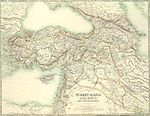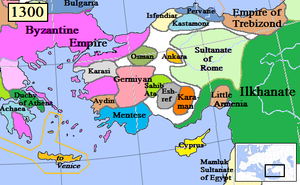Karamanids
This article needs additional citations for verification. (June 2011) |
Beylik of Karaman | |||||||||
|---|---|---|---|---|---|---|---|---|---|
| 1250–1487 | |||||||||
| Common languages | Persian,
Karaman Bey | ||||||||
• 1483–1487 | Mahmud Bey | ||||||||
| Historical era | Late Medieval | ||||||||
• Established | 1250 | ||||||||
• Disestablished | 1487 | ||||||||
| |||||||||
| History of Turkey |
|---|
 |
| Timeline |
|
|

The Karamanids (Turkish: Karamanoğulları or Karamanoğulları Beyliği), also known as the Emirate of Karaman and Beylik of Karaman (Turkish: Karamanoğulları Beyliği), was one of the Anatolian beyliks, centered in South-Central Anatolia around the present-day Karaman Province. From the mid 14th century until its fall in 1487, the Karamanid dynasty was one of the most powerful beyliks in Anatolia.[3]
History

The Karamanids traced their ancestry from Hodja Sad al-Din and his son
The Karamanids were members of the
The rivalry between
Good relations between the
After Karaman Bey died in 1262, his older son,
Despite these blows, the Karamanids continued to increase their power and influence, largely aided by the
As Ottoman power expanded into the Balkans, Aleaddin Ali Bey captured the city of Beyşehir, which had been an Ottoman city. However, it did not take much time for the Ottomans to react and march on Konya, the Karamanoğlu capital city. A treaty between the two kingdoms was formed, and peace existed until the reign of Bayezid I.
Ramazanoğlu Ali Bey captured
. Ramazanoğlu Ali Bey pursued and captured him; according to an agreement between the two leaders, Mehmet Bey was exiled to Egypt for the rest of his life.During the
Power of the Karamanid state in Anatolia
According to Mesâlik-ül-Ebsâr, written by Şehâbeddin Ömer, the Karamanid army had 25,000 riders and 25,000
Their economic activities depended mostly on control of strategic commercial areas such as Konya, Karaman and the ports of Lamos, Silifke, Anamur, and Manavgat.
Karamanid architecture

66
- Hasbey Medrese (1241)
- Şerafettin Mosque (13th century)
- İnce Minare (Dar-ül Hadis) Medrese (1258–1279)
- Hatuniye Medrese (Karaman)
- Mevlana Mosque and Tomb in Konya
- Mader-i Mevlana (Aktekke) mosque in Karaman
- Ibrahim Bey Mosque (Imaret) in Karaman
List of rulers
- Nûreddin Sûfi Bey (Capital City: Ereğli) (1250–1256)[1]
- Kerîmeddin Karaman Bey (Capital City: Ermenek) (1256?–1261)
- Şemseddin I. Mehmed Bey(1261–1277), notable for making Turkish the official language
- Güneri Bey (1277–1300)
- Bedreddin Mahmut Bey(1300–1308)
- Yahşı Han Bey (1308–1312) (Capital City: Konya)
- Bedreddin I. İbrahim Bey(1312–1333, 1348–1349)
- Alâeddin Halil Mirza Bey (1333–1348)
- Fahreddin Ahmed Bey (1349–1350)
- Şemseddin Bey (1350–1351)
- Mut) (1351–1356)
- Seyfeddin Süleyman Bey (1357–1361)
- Damad I. Alâeddin Ali Bey (1361–1398)
- Sultanzâde II. Mehmed Bey(1398–1399, 1402–1420, 1421–1423)
- Damad Bengi Ali Bey (1423–1424)
- Damad II. İbrahim Bey (1424–1464)
- Sultanzâde İshak Bey (1464)
- Sultanzâde Pîr Ahmed Bey(1464–1469)
- Kasım Bey (1469–1483)
- Turgutoğlu Mahmud Bey (1483–1487)
Family tree
| Karamanid dynasty | |||||||||||||||||||||||||||||||||||||||||||||||||||||||||||||||||||||||||||||||||||||||||||||||||||||||||||||||||||||||||||||||||||||||||||||||||||||||||||||||||||||||||||||||||||||||||||||||||||||||||||||||||||||||||||||||||||||||||||||||||||||||||||||||||||||||||||||||||||||||||||||||||||||||||||||||||||||||||||||||||||||||||||||||||||||||||||||||||||||||||||||||||||||||||||||||||||||||||||||||||||||||||||||||||||||||||||||||||||||||||||||||||||||||||||||||||||||||||||||||||||||||||||||||||||||||||||||||||||||||||||||||||||||||||||||||||||||||||||||||||||||||||||||||||||||||||||||||||||||||||||||||||||||||||||||||||||||||||||||||||||||||||||||||||||||||||||||||||||||||
|---|---|---|---|---|---|---|---|---|---|---|---|---|---|---|---|---|---|---|---|---|---|---|---|---|---|---|---|---|---|---|---|---|---|---|---|---|---|---|---|---|---|---|---|---|---|---|---|---|---|---|---|---|---|---|---|---|---|---|---|---|---|---|---|---|---|---|---|---|---|---|---|---|---|---|---|---|---|---|---|---|---|---|---|---|---|---|---|---|---|---|---|---|---|---|---|---|---|---|---|---|---|---|---|---|---|---|---|---|---|---|---|---|---|---|---|---|---|---|---|---|---|---|---|---|---|---|---|---|---|---|---|---|---|---|---|---|---|---|---|---|---|---|---|---|---|---|---|---|---|---|---|---|---|---|---|---|---|---|---|---|---|---|---|---|---|---|---|---|---|---|---|---|---|---|---|---|---|---|---|---|---|---|---|---|---|---|---|---|---|---|---|---|---|---|---|---|---|---|---|---|---|---|---|---|---|---|---|---|---|---|---|---|---|---|---|---|---|---|---|---|---|---|---|---|---|---|---|---|---|---|---|---|---|---|---|---|---|---|---|---|---|---|---|---|---|---|---|---|---|---|---|---|---|---|---|---|---|---|---|---|---|---|---|---|---|---|---|---|---|---|---|---|---|---|---|---|---|---|---|---|---|---|---|---|---|---|---|---|---|---|---|---|---|---|---|---|---|---|---|---|---|---|---|---|---|---|---|---|---|---|---|---|---|---|---|---|---|---|---|---|---|---|---|---|---|---|---|---|---|---|---|---|---|---|---|---|---|---|---|---|---|---|---|---|---|---|---|---|---|---|---|---|---|---|---|---|---|---|---|---|---|---|---|---|---|---|---|---|---|---|---|---|---|---|---|---|---|---|---|---|---|---|---|---|---|---|---|---|---|---|---|---|---|---|---|---|---|---|---|---|---|---|---|---|---|---|---|---|---|---|---|---|---|---|---|---|---|---|---|---|---|---|---|---|---|---|---|---|---|---|---|---|---|---|---|---|---|---|---|---|---|---|---|---|---|---|---|---|---|---|---|---|---|---|---|---|---|---|---|---|---|---|---|---|---|---|---|---|---|---|---|---|---|---|---|---|---|---|---|---|---|---|---|---|---|---|---|---|---|---|---|---|---|---|---|---|---|---|---|---|---|---|---|---|---|---|---|---|---|---|---|---|---|---|---|---|---|---|---|---|---|---|---|---|---|---|---|---|---|---|---|---|---|---|---|---|---|---|---|---|---|---|---|---|---|---|---|---|---|---|---|---|---|---|---|---|---|---|---|---|---|---|---|---|---|---|---|---|---|---|---|---|---|---|---|---|---|---|---|---|---|---|---|---|---|---|---|---|---|---|---|---|---|---|---|---|---|---|---|---|---|---|---|---|---|---|---|---|---|---|---|---|---|---|---|---|---|---|---|---|---|---|---|---|---|---|---|---|---|---|---|---|---|---|---|---|---|---|---|---|---|---|---|---|---|---|---|---|---|---|---|---|---|---|---|---|---|---|---|---|---|---|---|---|---|---|---|---|---|---|---|---|---|---|---|---|---|---|---|
| |||||||||||||||||||||||||||||||||||||||||||||||||||||||||||||||||||||||||||||||||||||||||||||||||||||||||||||||||||||||||||||||||||||||||||||||||||||||||||||||||||||||||||||||||||||||||||||||||||||||||||||||||||||||||||||||||||||||||||||||||||||||||||||||||||||||||||||||||||||||||||||||||||||||||||||||||||||||||||||||||||||||||||||||||||||||||||||||||||||||||||||||||||||||||||||||||||||||||||||||||||||||||||||||||||||||||||||||||||||||||||||||||||||||||||||||||||||||||||||||||||||||||||||||||||||||||||||||||||||||||||||||||||||||||||||||||||||||||||||||||||||||||||||||||||||||||||||||||||||||||||||||||||||||||||||||||||||||||||||||||||||||||||||||||||||||||||||||||||||||
See also
- Karamanlides
- Karaman
- Karaman Province
- Anatolian Turkish Beyliks
- List of Sunni Muslim dynasties
- Caramania
Notes
- ^ "The secondary literature often mentions that Turkish was made the official language by the Karamanid ruler of south-central Anatolia, Mehmed Beg, on his conquest of Konya in 1277. However, this derives from a statement by the Persian historian Ibn Bibi that was probably intended to discredit Mehmed Beg as a barbaric Turkmen. There is no other evidence that the Karamanids ever used Turkish for official purposes or even much for literary ones.” Andrew Peacock, personal communication, May 10, 2017.[2]
References
- ^ a b Türk Tarih Sitesi, Türk Tarihi, Genel Türk Tarihi, Türk Cumhuriyetleri, Türk Hükümdarlar – Tarih Archived 24 July 2011 at the Wayback Machine
- ^ Green 2019, p. 62.
- ISBN 9781438110257.
- ^ Boyacıoğlu, Ramazan (1999). Karamanoğulları'nın kökenleri (The Origin Of The Karamanids) Archived 19 March 2013 at the Wayback Machine. Language: Turkish. Cumhuriyet Üniversitesi İlahiyat Fakültesi Dergisi C.I S.3 Sivas 1999 s.,27–50
- ^ a b Cahen, Claude, Pre-Ottoman Turkey: A General Survey of the Material and Spiritual Culture and History c. 1071–1330, trans. J. Jones-Williams (New York: Taplinger, 1968), pp. 281–2.
- ^ Encyclopedia of Islam vol. IV, page 643.
Sources
- Leiser, Gary (2010). "The Turks in Anatolia before the Ottomans". In ISBN 978-0-521-83957-0.
His ally the Qaramanid Muhammad (r. 660–77/1261–78) did capture Konya in 675/1276 and attempted to replace Persian with Turkish as the official government language.
- Green, Nile (2019). "Introduction". In Green, Nile (ed.). The Persianate World: The Frontiers of a Eurasian Lingua Franca. University of California Press.
- ISBN 0-7914-0819-1.
Further reading
- Jackson, Cailah (2020). "Reframing the Qarāmānids: Exploring Cultural Life through the Arts of the Book". Al-Masāq: Journal of the Medieval Mediterranean. 33 (3): 257–281. S2CID 229485605.

